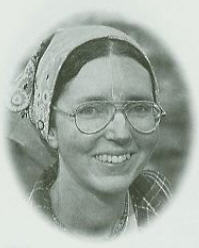
Hare Krsna Devi Dasi
I'VE WRITTEN HERE about Srila Prabhupada's plans to spread Krsna consciousness by developing varnasrama, the Vedic social system. If put into place in the coming century, what would varnasrama be like? A clue lies in what Srila Prabhupada said when asked how he planned to establish varnasrama: "I will go to Gita Nagari [ISKCON's farm in Pennsylvania]. I will sit down, and I will teach you how to live off the land."
Varnasrama is a social system based on the principle of simple living. But how does living off the land call for a whole social system? Suppose I want to be a vaisya, a farmer. Wouldn't getting a cow and planting some crops make me a vaisya? Not really.
I need cooperation from other groups. The essence of varnasrama is that each group must fulfill responsibilities that together provide for everyone's material needs and, ultimately, spiritual progress.
Let's take a look at the help I need to be a varnasrama farmer.
First of all, I need some land. In varnasrama, the ksatriya, or administrator, gives land to farmers like me. He also keeps law and order in society and provides for occupational training. (Traditionally, children would learn farming from their parents. Today, because most parents don't know farming, children would more likely learn at Krsna conscious school. In either case, the ksatriya is responsible to see they are properly trained.) A farmer not trained in growing crops, conserving soil, managing waste, caring for animals, and so on, will create havoc for himself and his community. So if I want to be a vaisya, the ksatriya provides what I need for training. In return for land, training, and protection, I give him twenty-five percent of what I produce.
Now I have land, animals, and some training, but I still can't work. I have no house to live in, no equipment to farm with. And even though I'm expert in growing crops and caring for my cows and oxen, I can't do all the work myself. I need assistant laborers, or sudras. In return for their labor, I make sure they have adequate food, clothing, and housing.
So we now have three social groups: vaisyas (farmers), ksatriyas (administrators), and sudras (laborers and craftsmen). We need a fourth group. Although ksatriyas provide the schools and support the teachers (Prabhupada spoke of a "varnasramacollege"), the actual teachers are brahmanas. In return for training and spiritual guidance, as a vaisya I make generous donations of food to the brahmanas and help provide their maintenance.
In addition to training citizens in occupational skills, the brahmanas give spiritual guidance to ensure that everyone works as an offering to Krsna [See sidebar, page 56]. By encouraging religious festivals and daily worship of the Deity, the brahmanasenliven people with the higher taste of spiritual life. That taste helps people give up selfish and destructive material desires. As a vaisya, I give money and whatever else I can in support of religious activities.
I've focused on vaisyas just to give a glimpse of the kinds of interaction required in a varnasrama society. Each group helps and gets help from the other groups. They work together for spiritual progress.
Srila Prabhupada wanted to set up varnasrama not only at Gita Nagari but all over the world. In 1977 Tamal Krsna Goswami, Srila Prabhupada's secretary at the time, described Prabhupada's enthusiasm for a new Australian farm project:
Srila Prabhupada was most enlivened to hear the report of the New Govardhana Farm. [He] said, "This is the next aspect of Krsna consciousness which I wish to push forward. If I am able to travel again, then I shall visit the farms and make them perfect. On these farms we can demonstrate the full varnasrama system. If these farms become successful, then the whole world will be enveloped by Krsna consciousness."
By creating rural varnasrama villages according to Srila Prabhupada's vision, the Krsna consciousness movement can change the state of the world in the twenty-first century from collapse and despair to meaningful social progress and spiritual fulfillment.
Hare Krsna Devi Dasi, an ISKCON devotee since 1978, is co-editor of the newsletter Hare Krsna Rural Life.
Different Offerings, Same Access to Spiritual Gain
IN VARNASRAMA the underlying goal of daily work is to please the Supreme Lord. Different workers in a rural community make different offerings, but everyone has an equal opportunity for spiritual progress.
A sudra makes his offering to the Lord using material elements and his own talents or services. A sudra may create a sculpture or a painting or a building. He may create a song or a dance or some music. He may make a saw or a wagon or an ox yoke. He may clean, help farm, repair buildings, or do clerical work. In a Krsna conscious society, a sudra can do these and similar tasks in a devotional consciousness and offer them to Krsna.
The vaisya makes his offering using plants and animals. He raises crops, takes care of cows, and trades his surplus, providing the food needed by society. He should offer to the Lord both his produce and his labor.
The ksatriya makes his offering by carefully leading and protecting the citizens. He must follow the Vedic aphorism sarve sukhino bhavantu: "Make everyone happy." The ksatriya can offer Krsna a well-organized society where each person can become spiritually satisfied doing his occupational duty.
The brahmana makes his offering to the Lord by using knowledge, scripture, and sacred paraphernalia. For example, he may use lamps and incense to worship the Deity in the temple, or in the role of teacher he may use practical knowledge to train others in their occupations while revealing to them the spiritual dimension of work.
